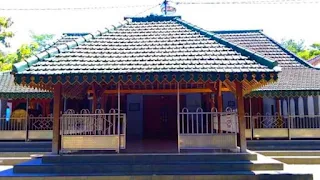Islam entered Ponorogo in the early 15th century when the Majapahit Kingdom began to collapse and the Demak Sultanate was established. The fall of Majapahit caused the Wengker region to fragment, leading to the emergence of local rulers who held significant influence over their surrounding communities.
The arrival of Islam in Ponorogo can be traced back to Raden Katong, who came along with Ki Ageng Mirah and Patih Seloaji. This period marks the early phase of Islamic propagation in the former Wengker region, which would later become Ponorogo Regency.
After the passing of Ki Ageng Mirah, Islamic preaching in Ponorogo was continued by Kyai Donopuro. Genealogically, Kyai Donopuro, whose real name was Pangeran Sumendhe Ragil, was a son of Sunan Bayat.
Following Kyai Donopuro’s passing, the spread of Islam was carried on by one of his students, Kyai Muhammad Besari, also known as Kyai Ageng Besari, who founded the Gebang Tinatar Tegalsari Islamic boarding school. Kyai Muhammad Hasan Besari was the son of Ki Ageng Anom Besari, the caretaker of Caruban. After Kyai Ageng Besari passed away, the spread of Islam in Ponorogo and its surroundings continued through his descendants and students.
Interestingly, each of these Islamic scholars and preachers had the habit of establishing mosques as centers of their preaching activities. This practice was likely a tradition passed down from their teachers, the Walisongo (Nine Saints of Islam in Java). For example, Sunan Ampel, Sunan Giri, Sunan Kalijaga, and other members of the Walisongo, including Sunan Bayat, all built mosques to serve as centers of religious education.
Similarly, in Ponorogo, the historical traces of these Islamic scholars can be followed through the mosques they built, which stand as historical legacies. Unfortunately, not all of these mosques have been preserved in their original architectural form. Due to the passage of time and various other factors, many of them have undergone significant renovations.
Below are seven old mosques built by prominent Islamic scholars in Ponorogo, listed according to their period of construction:
Ki Ageng Mirah Mosque
Ki Ageng Mirah’s original name was Ki Muslim, the son of Ki Ageng Gribig. The name "Mirah" was derived from his daughter’s name and later became associated with both him and the region he governed.
Jami Kauman Kota Lama Mosque
This mosque was established in 1560 by Adipati Sepuh, the fifth regent of Ponorogo, who was a descendant of Batoro Katong. The mosque, more commonly known as Masjid Kauman Kota Lama, once served as the Grand Mosque of Ponorogo when the regency’s administrative center was still located in Kuto Wetan.Kuto Wetan itself has since disappeared, leaving only this mosque as its remaining structure. Originally, the mosque was located to the west of the town square, while the administrative center was situated to the north, in what is now likely the Kadipaten subdistrict. Several parts of the mosque have been renovated, but some original features characteristic of old mosques remain.
Baiturrohman Mosque (Kyai Ageng Donopuro)
Located in Setono Hamlet, Tegalsari Village, Jetis District, this mosque, according to an inscription inside, was built in the year 1600 by Kyai Donopuro, Kyai Noyopuro, and Kyai Wongsopuro.Initially, the mosque was made of teak wood, supported by four large pillars, and had enough space to accommodate around 40 worshippers, the minimum required for holding Friday prayers according to the Shafi'i school of Islamic law. Over time, the mosque underwent several renovations, with the most significant one taking place in 2021. The only original structures that remain are the four main pillars and the bedug (large drum) at the mosque’s front.
Tegalsari Mosque
Located in Tegalsari Village, Jetis District, Tegalsari Mosque was built around the 1740s by Ki Ageng Muhammad Besari, the founder of the Gebang Tinatar Tegalsari Islamic boarding school. Inside the mosque, there is a manuscript written by Ranggawarsita, a poet of the Surakarta royal court and a student of Ki Ageng Muhammad Besari, which is between 150 and 170 years old.The mosque is frequently visited by tourists, particularly on Thursday nights. Visitors not only perform i'tikaf (spiritual retreat) in the mosque but also visit the tomb of Ki Ageng Muhammad Besari, which is located behind the mosque.
Al Ishaq Mosque (Coper)
Located in Coper Village, Jetis District, this mosque was founded in the 17th century by Kyai Ishaq, the son of Kyai Ageng Muhammad Besari. Kyai Muhammad Ishaq was reportedly his father’s favored son and was encouraged to establish an Islamic boarding school in Coper.The mosque was originally gifted by Kyai Muhammad Besari to his son when Kyai Ishaq was assigned to spread Islam in the Coper area. Before the mosque was relocated to Coper, the new Tegalsari Mosque was completed around 1750 AD.
Imam Puro Mosque
Located in Sukosari Village, Ponorogo, this mosque was established by Kyai Imam Puro in 1778. Kyai Imam Puro came to Sukosari to propagate Islam after studying under Kyai Ageng Muhammad Besari at the Gebang Tinatar Tegalsari boarding school. According to historical accounts, Kyai Imam Puro was instructed by Kyai Ageng Besari to spread Islam in the northwestern region of Ponorogo, bordering Magetan.The mosque has undergone several renovations over the years, in 1850, 1960, and the most recent in 2021. However, some original features remain, including the main hall, bedug, kentongan (traditional wooden drum), and an old well at the front of the mosque. Additionally, large sawo kecik and mentega trees still stand in front of the mosque.
Tjokronegoro Grand Mosque (Ponorogo)
The Ponorogo Grand Mosque, located on Aloon-Aloon Barat Street, Ponorogo Regency, was built in 1858 during the rule of Raden Mas Adipati Aryo Tjokronegoro, a grandson of Kyai Ageng Muhammad Besari.The mosque's main structure is an original relic from the time of Adipati Tjokronegoro, featuring 16 teak pillars. According to historical sources, these teak pillars were made from a single massive teak tree, crafted by woodworkers from the Surakarta Kingdom.
In the mosque’s courtyard, there is a row of sawo kecik trees, which is a characteristic feature of mosques in Ponorogo.







